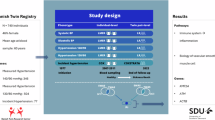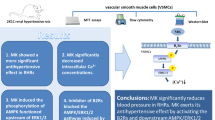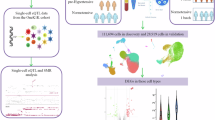Abstract
Ephrin B2 (EFNB2) is a ligand for erythropoietin-producing hepatocellular kinases (EPH), the largest family of receptor tyrosine kinases. It has critical functions in many biological systems, but is not known to regulate blood pressure. We generated mice with a smooth muscle cell (SMC)-specific deletion of EFNB2 and investigated its roles in blood pressure regulation and vascular SMC (VSMC) contractility. Male Efnb2 knockout (KO) mice presented reduced blood pressure, whereas female KO mice had no such reduction. Both forward signaling from EFNB2 to EPHs and reverse signaling from EPHs to EFNB2 were involved in regulating VSMC contractility, with EPHB4 serving as a critical molecule for forward signaling, based on crosslinking studies. We also found that a region from aa 313 to aa 331 in the intracellular tail of EFNB2 was essential for reverse signaling regulating VSMC contractility, based on deletion mutation studies. In a human genetic study, we identified five SNPs in the 3′ region of the EFNB2 gene, which were in linkage disequilibrium and were significantly associated with hypertension for male but not female subjects, consistent with our findings in mice. The coding (minor) alleles of these five SNPs were protective in males. We have thus discovered a previously unknown blood pressure-lowering mechanism mediated by EFNB2 and identified EFNB2 as a gene associated with hypertension risk in humans.
Similar content being viewed by others
Log in or create a free account to read this content
Gain free access to this article, as well as selected content from this journal and more on nature.com
or
References
Unified nomenclature for Eph family receptors and their ligands, the ephrins. Eph Nomenclature Committee. Cell 1997; 90: 403–404.
Pasquale EB : Eph-ephrin bidirectional signaling in physiology and disease. Cell 2008; 133: 38–52.
Luo H, Yu G, Tremblay J, Wu J : EphB6-null mutation results in compromised T cell function. J Clin Investig 2004; 114: 1762–1773.
Batlle E, Henderson JT, Beghtel H et al: Beta-catenin and TCF mediate cell positioning in the intestinal epithelium by controlling the expression of EphB/ephrinB. Cell 2002; 111: 251–263.
Konstantinova I, Nikolova G, Ohara-Imaizumi M et al: EphA–Ephrin-A-mediated beta cell communication regulates insulin secretion from pancreatic islets. Cell 2007; 129: 359–370.
Salvucci O, de la Luz Sierra M, Martina JA et al: EphB2 and EphB4 receptors forward signaling promotes SDF-1-induced endothelial cell chemotaxis and branching remodeling. Blood 2006; 108: 2914–2922.
Luo H, Broux B, Wang X et al: EphrinB1 and EphrinB2 regulate T cell chemotaxis and migration in experimental autoimmune encephalomyelitis and multiple sclerosis. Neurobiol Dis 2016; 91: 292–306..
Kaushal GP, Shah SV : The new kids on the block: ADAMTSs, potentially multifunctional metalloproteinases of the ADAM family. J Clin Investig 2000; 105: 1335–1337.
Primakoff P, Myles DG : The ADAM gene family: surface proteins with adhesion and protease activity. Trends Genet 2000; 16: 83–87.
Georgakopoulos A, Litterst C, Ghersi E et al: Metalloproteinase/Presenilin1 processing of ephrinB regulates EphB-induced Src phosphorylation and signaling. Embo J 2006; 25: 1242–1252.
Tomita T, Tanaka S, Morohashi Y et al: Presenilin-dependent intramembrane cleavage of ephrin-B1. Mol Neurodegener 2006; 1: 2.
Xin HB, Deng KY, Rishniw M et al: Smooth muscle expression of Cre recombinase and eGFP in transgenic mice. Physiol Genomics 2002; 10: 211–215.
Dumas P, Pausova Z, Kren V et al: Contribution of autosomal loci and the Y chromosome to the stress response in rats. Hypertension 2000; 35: 568–573.
Luo H, Charpentier T, Wang X et al: Efnb1 and Efnb2 proteins regulate thymocyte development, peripheral T cell differentiation, and antiviral immune responses and are essential for interleukin-6 (IL-6) signaling. J Biol Chem 2011; 286: 41135–41152.
Luo H, Wan X, Wu Y et al: Cross-linking of EphB6 resulting in signal transduction and apoptosis in Jurkat cells. J Immunol 2001; 167: 1362–1370.
Luo H, Wu Z, Qi S et al: Ephrinb1 and Ephrinb2 are associated with interleukin-7 receptor alpha and retard its internalization from the cell surface. J Biol Chem 2011; 286: 44976–44987.
Luo H, Yu G, Wu Y et al: EphB6 crosslinking results in costimulation of T cells. J Clin Investig 2002; 110: 1141–1150.
Wu J, Luo H : Recent advances on T-cell regulation by receptor tyrosine kinases. Curr Opin Hematol 2005; 12: 292–297.
Yu G, Luo H, Wu Y et al: Ephrin B2 induces T cell costimulation. J Immunol 2003; 171: 106–114.
Yu G, Luo H, Wu Y et al: Mouse ephrinB3 augments T-cell signaling and responses to T-cell receptor ligation. J Biol Chem 2003; 278: 47209–47216.
Yu G, Luo H, Wu Y et al: EphrinB1 is essential in T-cell-T-cell co-operation during T-cell activation. J Biol Chem 2004; 279: 55531–55539.
Yu G, Mao J, Wu Y et al: Ephrin-B1 is critical in T-cell development. J Biol Chem 2006; 281: 10222–10229.
Hashimoto T, Karasawa T, Saito A et al: Ephrin-B1 localizes at the slit diaphragm of the glomerular podocyte. Kidney Int 2007; 72: 954–964.
Dravis C, Wu T, Chumley MJ et al: EphB2 and ephrin-B2 regulate the ionic homeostasis of vestibular endolymph. Hear Res 2007; 223: 93–104.
Luo H, Wu Z, Tremblay J et al: Receptor tyrosine kinase Ephb6 regulates vascular smooth muscle contractility and modulates blood pressure in concert with sex hormones. J Biol Chem 2012; 287: 6819–6829.
Wu Z, Luo H, Thorin E et al: Possible role of Efnb1 protein, a ligand of Eph receptor tyrosine kinases, in modulating blood pressure. J Biol Chem 2012; 287: 15557–15569.
Wang Y, Thorin E, Luo H et al: EPHB4 protein expression in vascular smooth muscle cells regulates their contractility, and EPHB4 deletion leads to hypotension in mice. J Biol Chem 2015; 290: 14235–14244.
Colagiuri S, Cooper M, Grobbee R et al: Prevention of Vascular Outcomes in Type 2 Diabetes: Benefits of Intensive Blood Pressure and Blood Glucose Control with Preterax and Diamicron MR, Issue III. France: Wolters Kluwer Health France, 2008.
Advance Trial/Action in Diabetes and Vascular Disease: PreterAx and Diamicron MR Controlled Evaluation. Available at: www.advance-trial.com. Accessed on November 2014.
Ramachandran C, Patil RV, Combrink K et al: Rho-Rho kinase pathway in the actomyosin contraction and cell-matrix adhesion in immortalized human trabecular meshwork cells. Mol Vis 2011; 17: 1877–1890.
Roberts RE : The role of Rho kinase and extracellular regulated kinase-mitogen-activated protein kinase in alpha2-adrenoceptor-mediated vasoconstriction in the porcine palmar lateral vein. J Pharmacol Exp Therap 2004; 311: 742–747.
Klemke RL, Cai S, Giannini AL et al: Regulation of cell motility by mitogen-activated protein kinase. J Cell Biol 1997; 137: 481–492.
Hedges JC, Oxhorn BC, Carty M et al: Phosphorylation of caldesmon by ERK MAP kinases in smooth muscle. Am J Physiol Cell Physiol 2000; 278: C718–C726.
Altman DG, Bland JM : Interaction revisited: the difference between two estimates. Bmj 2003; 326: 219.
Seda O, Tremblay J, Gaudet D et al: Systematic, genome-wide, sex-specific linkage of cardiovascular traits in French Canadians. Hypertension 2008; 51: 1156–1162.
Nakayama A, Nakayama M, Turner CJ et al: Ephrin-B2 controls PDGFRbeta internalization and signaling. Genes Dev 2013; 27: 2576–2589.
Bruckner K, Pasquale EB, Klein R : Tyrosine phosphorylation of transmembrane ligands for Eph receptors. Science 1997; 275: 1640–1643.
Cowan CA, Henkemeyer M : The SH2/SH3 adaptor Grb4 transduces B-ephrin reverse signals. Nature 2001; 413: 174–179.
Arvanitis D, Davy A : Eph/ephrin signaling: networks. Genes Dev 2008; 22: 416–429.
Lu Q, Sun EE, Klein RS et al: Ephrin-B reverse signaling is mediated by a novel PDZ-RGS protein and selectively inhibits G protein-coupled chemoattraction. Cell 2001; 105: 69–79.
Traish AM, Miner MM, Morgentaler A et al: Testosterone deficiency. Am J Med 2011; 124: 578–587.
Zitzmann M : Testosterone deficiency, insulin resistance and the metabolic syndrome. Nat Rev Endocrinol 2009; 5: 673–681.
Nelson LR, Bulun SE : Estrogen production and action. J Am Acad Dermatol 2001; 45: S116–S124.
National Kidney Foundation: K/DOQI clinical practice guidelines for chronic kidney disease: evaluation, classification, and stratification. Am J Kidney Dis 2002; 39: S1–266.
Schiffrin EL, Lipman ML, Mann JF : Chronic kidney disease: effects on the cardiovascular system. Circulation 2007; 116: 85–97.
Klag MJ, Whelton PK, Randall BL et al: Blood pressure and end-stage renal disease in men. N Engl J Med 1996; 334: 13–18.
International Consortium for Blood Pressure Genome-Wide Association Studies, Ehret GB, Munroe PB et al: Genetic variants in novel pathways influence blood pressure and cardiovascular disease risk. Nature 2011; 478: 103–109.
Acknowledgements
This work was supported by grants from the Canadian Institutes of Health Research to JW (MOP57697, MOP69089 and MOP 123389), HL (MOP97829), ET (MOP14496) and JT (ISO106797). It was also funded by grants from the Heart and Stroke Foundation of Quebec, the Natural Sciences and Engineering Research Council of Canada (203906-2012), the Juvenile Diabetes Research Foundation (17-2013-440), the Fonds de recherche du Québec-Santé (Ag-06) and the J-Louis Lévesque Foundation to JW.
Author information
Authors and Affiliations
Corresponding author
Ethics declarations
Competing interests
The authors declare no conflict of interest.
Additional information
Supplementary Information accompanies this paper on European Journal of Human Genetics website
Supplementary information
Rights and permissions
About this article
Cite this article
Wang, Y., Hamet, P., Thorin, E. et al. Reduced blood pressure after smooth muscle EFNB2 deletion and the potential association of EFNB2 mutation with human hypertension risk. Eur J Hum Genet 24, 1817–1825 (2016). https://doi.org/10.1038/ejhg.2016.105
Received:
Revised:
Accepted:
Published:
Issue date:
DOI: https://doi.org/10.1038/ejhg.2016.105
This article is cited by
-
Identification of genetic loci affecting body mass index through interaction with multiple environmental factors using structured linear mixed model
Scientific Reports (2021)
-
EPHB6 and testosterone in concert regulate epinephrine release by adrenal gland chromaffin cells
Scientific Reports (2018)
-
Analysis of the association of EPHB6, EFNB1 and EFNB3 variants with hypertension risks in males with hypogonadism
Scientific Reports (2018)
-
EPHA6 rs4857055 C > T polymorphism associates with hypertension through triglyceride and LDL particle size in the Korean population
Lipids in Health and Disease (2017)
-
Evidence from single nucleotide polymorphism analyses of ADVANCE study demonstrates EFNB3 as a hypertension risk gene
Scientific Reports (2017)



